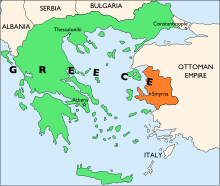Our website is made possible by displaying online advertisements to our visitors.
Please consider supporting us by disabling your ad blocker.
Occupation of Smyrna
| Zone of Smyrna Ζώνη Σμύρνης | |||||||||
|---|---|---|---|---|---|---|---|---|---|
| Dependency of Greece | |||||||||
| 1919–1922 | |||||||||
 | |||||||||
| Capital | Smyrna | ||||||||
| Government | |||||||||
| High Commissioner | |||||||||
• 1919–1922 | Aristeidis Stergiadis | ||||||||
| Historical era | Greco-Turkish War (1919–1922) | ||||||||
• Established | 15 May 1919 | ||||||||
• Disestablished | 9 September 1922 | ||||||||
| |||||||||
| Today part of | Turkey | ||||||||
The city of Smyrna (modern-day İzmir) and surrounding areas were under Greek military occupation from 15 May 1919 until 9 September 1922. The Allied Powers authorized the occupation and creation of the Zone of Smyrna (Greek: Ζώνη Σμύρνης, romanized: Zóni Smýrnis) during negotiations regarding the partition of the Ottoman Empire to protect the ethnic Greek population living in and around the city. The Greek landing on 15 May 1919 was celebrated by the substantial local Greek population but quickly resulted in ethnic violence in the area. This violence decreased international support for the occupation and led to a rise in Turkish nationalism. The high commissioner of Smyrna, Aristeidis Stergiadis, firmly opposed discrimination against the Turkish population by the administration; however, ethnic tensions and discrimination remained. Stergiadis also began work on projects involving resettlement of Greek refugees, the foundations for a university, and some public health projects. Smyrna was a major base of operations for Greek troops in Anatolia during the Greco-Turkish War (1919–1922).
The Greek occupation of Smyrna ended on 9 September 1922 with the Turkish capture of Smyrna by troops commanded by Mustafa Kemal Atatürk. After the Turkish advance on Smyrna, a mob murdered the Orthodox bishop Chrysostomos and a few days later the Great Fire of Smyrna burnt large parts of the city (including most of the Greek and Armenian areas). Estimated Greek and Armenian deaths range from 10,000 to 100,000.[1][2][3][4] With the end of the occupation of Smyrna, major combat in Anatolia between Greek and Turkish forces largely ended, and on 24 July 1923, the parties signed the Treaty of Lausanne ending the war.
- ^ Naimark. Fires of Hatred, pp. 47–52.
- ^ Biondich, Mark (2011). The Balkans: Revolution, War, and Political Violence Since 1878. Oxford University Press. p. 92. ISBN 9780199299058.
- ^ Naimark, Norman M. Fires of Hatred: Ethnic Cleansing in Twentieth-Century Europe. Cambridge: MA: Harvard University Press, 2002, p. 52.
- ^ Irving Louis Horowitz; Rudolph J. Rummel (1994). "Turkey's Genocidal Purges". Death by Government. Transaction Publishers. ISBN 978-1-56000-927-6., p. 233.
Previous Page Next Page




